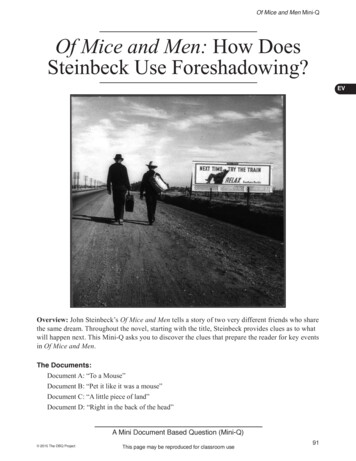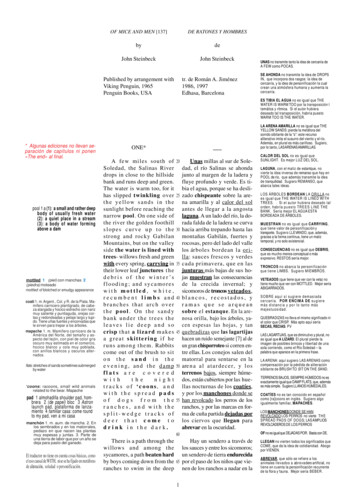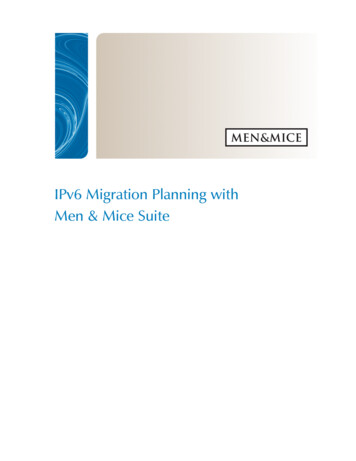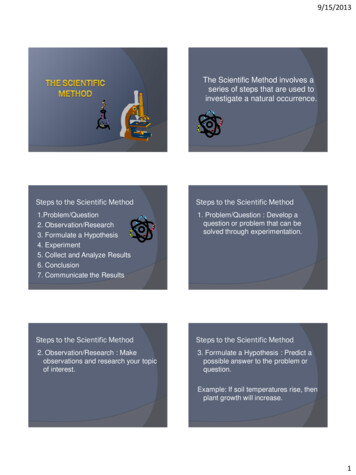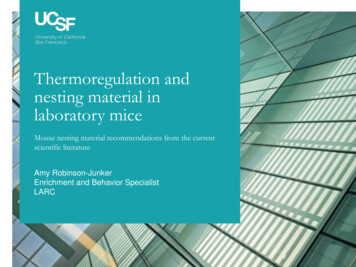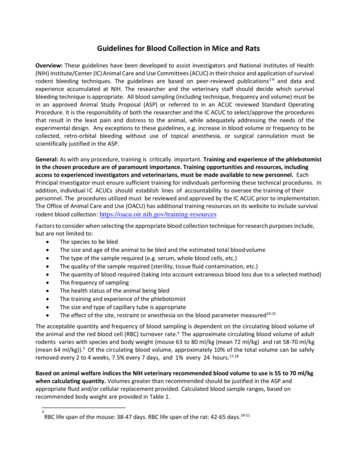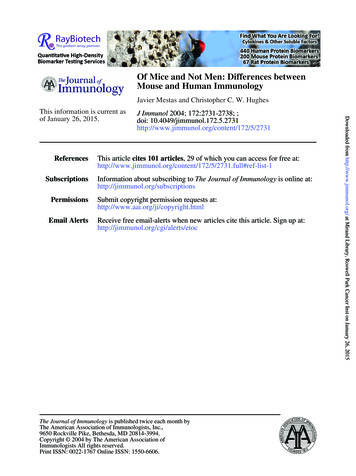
Transcription
Of Mice and Not Men: Differences betweenMouse and Human ImmunologyJavier Mestas and Christopher C. W. HughesReferencesSubscriptionsPermissionsEmail AlertsJ Immunol 2004; 172:2731-2738; ;doi: /content/172/5/2731This article cites 101 articles, 29 of which you can access for free #ref-list-1Information about subscribing to The Journal of Immunology is online at:http://jimmunol.org/subscriptionsSubmit copyright permission requests at:http://www.aai.org/ji/copyright.htmlReceive free email-alerts when new articles cite this article. Sign up at:http://jimmunol.org/cgi/alerts/etocThe Journal of Immunology is published twice each month byThe American Association of Immunologists, Inc.,9650 Rockville Pike, Bethesda, MD 20814-3994.Copyright 2004 by The American Association ofImmunologists All rights reserved.Print ISSN: 0022-1767 Online ISSN: 1550-6606.Downloaded from http://www.jimmunol.org/ at Mirand Library, Roswell Park Cancer Inst on January 26, 2015This information is current asof January 26, 2015.
OFTHEJOURNAL IMMUNOLOGYBRIEF REVIEWSOf Mice and Not Men: Differences between Mouse andHuman ImmunologyJavier Mestas and Christopher C. W. Hughes1sarily true in humans. By making such assumptions we run therisk of overlooking aspects of human immunology that do notoccur, or cannot be modeled, in mice. Included in this subsetwill be differences that may preclude a successful preclinicaltrial in mice becoming a successful clinical trial in human.In this review our aim is not to suggest that the mouse is aninvalid model system for human biology. Clearly, with so manyparadigms that translate well between the species, and with therelative ease with which mice can now be genetically manipulated, mouse models will continue to provide important information for many years to come. Rather, our aim is to sound aword of caution. As therapies for human diseases become evermore sophisticated and specifically targeted, it becomes increasingly important to understand the potential limitations of extrapolating data from mice to humans. The literature is litteredwith examples of therapies that work well in mice but fail toprovide similar efficacy in humans (2–7). By focusing on someknown differences between mouse and human immunology wehope to spur interest in this area and encourage others to notedifferences where they occur.Structure and general characteristicsice are the mainstay of in vivo immunological experimentation and in many respects they mirror human biology remarkably well. This conservation offunction is reflected in recent reports on the sequencing of boththe human and mice genomes, which reveal that to date only300 or so genes appear to be unique to one species or the other(1). Despite this conservation there exist significant differencesbetween mice and humans in immune system development, activation, and response to challenge, in both the innate andadaptive arms. Such differences should not be surprising as thetwo species diverged somewhere between 65 and 75 millionyears ago, differ hugely in both size and lifespan, and haveevolved in quite different ecological niches where widely different pathogenic challenges need to be met—after all, most of usdo not live with our heads a half-inch off the ground. However,because there are so many parallels there has been a tendency toignore differences and in many cases, perhaps, make the assumption that what is true in mice—in vivo veritas—is neces-The overall structure of the immune system in mice and humans is quite similar. As this topic has been recently reviewed indepth (8), we will not go into great detail here. One differenceworth noting is that whereas mice have significant bronchusassociated lymphoid tissue, this is largely absent in healthy humans (9), possibly reflecting a higher breathable Ag load for animals living so much closer to the ground.The balance of lymphocytes and neutrophils in adult animalsis quite different: human blood is neutrophil rich (50 –70%neutrophils, 30 –50% lymphocytes) whereas mouse blood has astrong preponderance of lymphocytes (75–90% lymphocytes,10 –25% neutrophils) (10). It is not clear what, if any, functional consequence this shift toward neutrophil-rich blood inhumans has had.Tyrosine kinase receptor expression on putative hemopoieticstem cells (HSC)2 shows a reciprocal pattern, with mouse HSCbeing predominantly c-kithigh, flt-3 , whereas human HSC arepredominantly c-kitlow, flt-3 (11).Center for Immunology and Department of Molecular Biology and Biochemistry, University of California, Irvine, CA 926971Address correspondence and reprint requests to Dr. Christopher Hughes, Department ofMolecular Biology and Biochemistry, McGaugh Hall; University of California, Irvine, CA92697. E-mail address: cchughes@uci.edu.MReceived for publication November 12, 2003. Accepted for publication January 23, 2004.2The costs of publication of this article were defrayed in part by the payment of page charges.This article must therefore be hereby marked advertisement in accordance with 18 U.S.C.Section 1734 solely to indicate this fact.Copyright 2004 by The American Association of Immunologists, Inc.Abbreviations used in this paper: HSC, hemopoietic stem cells; iNOS, inducible NOsynthase; c, common -chain; DETC, dendritic epidermal T cells; MS, multiple sclerosis;DTH, delayed-type hypersensitivity; EC, endothelial cells.0022-1767/04/ 02.00Downloaded from http://www.jimmunol.org/ at Mirand Library, Roswell Park Cancer Inst on January 26, 2015Mice are the experimental tool of choice for the majority ofimmunologists and the study of their immune responseshas yielded tremendous insight into the workings of thehuman immune system. However, as 65 million years ofevolution might suggest, there are significant differences.Here we outline known discrepancies in both innate andadaptive immunity, including: balance of leukocyte subsets, defensins, Toll receptors, inducible NO synthase, theNK inhibitory receptor families Ly49 and KIR, FcR, Igsubsets, the B cell (BLNK, Btk, and 5) and T cell(ZAP70 and common -chain) signaling pathway components, Thy-1, T cells, cytokines and cytokine receptors, Th1/Th2 differentiation, costimulatory moleculeexpression and function, Ag-presenting function of endothelial cells, and chemokine and chemokine receptor expression. We also provide examples, such as multiple sclerosis and delayed-type hypersensitivity, where complexmulticomponent processes differ. Such differences shouldbe taken into account when using mice as preclinical models of human disease. The Journal of Immunology, 2004,172: 2731–2738.
2732Innate immunityAdaptive immunityFcR represent a link between the adaptive immune system,which generates Ab, and the innate immune system, which canrespond to Ab-Ag complexes through capture by FcR expressedon macrophages, neutrophils, eosinophils, mast cells, and dendritic cells. There are several differences in FcR expression between mice and humans. In humans, Fc RI (CD89) is an important IgA receptor expressed by neutrophils, eosinophils,monocytes/macrophages, dendritic cells, and Kupffer cells(21). Mice lack Fc RI and presumably use alternative receptors, such as Fc / R, the transferrin receptor (CD71) andpolymeric IgR, which also binds IgM. Humans also express twoIgG receptors not found in mice: Fc RIIA and Fc RIIC areclosely related single-chain FcR, each of which has a singleITAM motif in the intracellular domain. In contrast, mostother FcR associate with ITAM-containing signal transductionsubunits (22).In addition to differences in FcR there are well-known differences in expression of Ig isotypes between mice and humans,and direct correlations between subtypes within classes in eachspecies are hard to make. Mice make IgA, IgD, IgE, IgM, andfour subtypes of IgG: IgG1, IgG2a, IgG2b, and IgG3. Interestingly, in the C57BL/6, C57BL/10, SJL, and NOD strains ofmice there is no expression of IgG2a, instead these mice expressthe novel IgG2c (23). Humans in contrast express two subtypesof IgA—IgA1 and IgA2—along with single forms of IgD, IgE,and IgM. In humans there are also four subtypes of IgG: IgG1,IgG2, IgG3, and IgG4; however, these are not direct homologues of the mouse proteins. While different subtypes have differing abilities to bind FcR or fix complement, the differencesbetween mice and humans are not considered significant. Incontrast, there are differences in class switching: in mice, IL-4induces IgG1 and IgE, whereas in humans, IL-4 inducesswitching to IgG4 and IgE. In contrast, IL-13 has no effect onmouse B cells but induces switching to IgE in humans (24).There are some interesting differences in B cell developmentthat relate to the roles of several signaling molecules. BLNK (Srchomology-2 domain containing leukocyte-specific phosphoprotein-65) is an adapter protein that is rapidly phosphorylatedby Syk after cross-linking of the B cell Ag receptor. It then servesas a scaffold for downstream signaling components such asGrb2, Vav, Nck, and PLC- . B cell development in mice lacking BLNK is blocked at the pro-B to pre-B transition, resultingin low numbers of IgM B cells, but no mature IgMlowIgDhighB cells, appearing in the periphery (25). A naturally occurringmutation in the human BLNK protein has been identified thatresults in a splicing defect preventing protein expression. In thispatient there was also a block in the pro-B to pre-B transition;however, there was also a complete absence of B cells in the periphery, suggesting a more severe block in human B cell development than in mice (26).Similarly discrepant phenotypes have been noted in micelacking functional BCR-associated tyrosine kinase Btk (27) andin mice lacking 5 (28), the L chain component of the pre-BCR(Table I). Differences in mature B cells between mice and humans were recently reviewed (29), and include mutually exclusive expression of CD5 and CD23 on mouse but not human Bcell subsets, and CD38 expression on human, but not mouse,plasma cells.The discrepant phenotypes discussed above for BLNK, Btk,and 5 should be treated with some caution as the human diseases usually arise due to mutations in the relevant genes ratherthan deletions of whole exons as seen in the mouse knockoutmodels. In some cases, however, identical mutations have beenfound, or created, in mice and the discrepant phenotype remains. This is the case for human XLA and mouse XID, whichboth involve Btk (30, 31).The development and regulation of T cells also differs between mice and humans. Thy-1 is a GPI-linked Ig superfamilymolecule of unknown function. It is expressed on thymocytesand peripheral T cells in mice and has been widely used as a Tcell marker in the thymus. In humans, however, it is only expressed on neurons. The basis of this tissue specificity is suggested to be the presence or absence of an Ets-1 binding site inthe third intron of the gene (32).Downloaded from http://www.jimmunol.org/ at Mirand Library, Roswell Park Cancer Inst on January 26, 2015One of the first lines of defense in higher organisms, and oftenthe only defense in lower animals, is the growing family of antimicrobial peptides, and in particular the defensins. These areimportant in mucosal defense in the gut and in epithelial defense in skin and elsewhere (12, 13). Neutrophils are a richsource of leukocyte defensins in humans, but defensins are notexpressed by neutrophils in mice (14). In contrast, Paneth cells,which are present in the crypts of the small intestine, express 20 defensins (cryptdins) in mice but only two in human,likely reflecting different evolutionary pressures related to microorganism exposure through food intake. There are also differences in processing of defensins (Table I).The last few years have seen a renewed focus on the field ofinnate immunology, spurred in large part by identification ofthe Toll-like family of receptors—the TLRs (15). This field isstill relatively young and so far a limited number of differenceshave been noted between mice and humans (Table I).There has been considerable controversy as to whether human macrophages express NO. Expression of functional inducible NO synthase (iNOS; NOS2) in mouse macrophages hasbeen clearly demonstrated and iNOS mRNA is readily inducedby IFN- and LPS (16). However, these same inflammatorymediators have failed to show consistent effects on human macrophages, hence the confusion. Recent work suggests that othermediators, such as IFN- , IL-4 plus anti-CD23, and variouschemokines, are actually far more efficient in inducing iNOS inhuman macrophages (17). However, the controversy is notdead yet (18).Using different strains of mice a susceptibility locus for CMVinfection, cmv1, was identified and later shown to encode theLy49 family of proteins (19). There are at least 14 members andmost are expressed on NK and NKT cells, where the majorityact as NK inhibitory receptors for MHC I molecules. The Ly49family is absent in humans, who use the KIR family as NK inhibitory receptors (20). KIR proteins are highly diverged fromthe Ly49 family and have Ig rather than C-type lectin domainsin their extracellular domain; however, similarly to Ly49 theyalso recognize MHC class I. The ligands for mouse and humanNKG2D differ: in humans, NKG2D binds the polymorphicMHC class I-like molecules MHC-I chain-related A, MHC-Ichain-related B, and the UL16 binding protein family, whereasin mouse NKG2D binds to H-60 and Rae1 . The significanceof these differences to CMV infection and to NK biology ingeneral have not been determined.BRIEF REVIEW
The Journal of Immunology2733Table I. Summary of some known immunological differences between mouse and humanMouseHemotopoiesis in spleenPresence of BALTNeutrophils in periph. bloodLymphocytes in periph. bloodHemotopoietic stem cellsTLR2 expression on PBLTLR3TLR9Paneth cell defensinsMacrophage NOCD4 on macrophagesPredominant T cells in skin andmucosa / T cells respond to phosphoantigensCD1 genesNK inhibitory Rs for MHC 1NKG2D ligandsfMLP receptor affinityFc RIFc RIIA, CSerum IgAIg classesAbsent / TCR (dendritic epidermal Tcells—DETC)NoCD1dLy49 family (except Ly49D and H)H-60, Rae1 LowAbsentAbsentMostly polymericIgA, IgD, IgE, IgG1, IgG2a*, IgG2b,IgG3, IgM * absent in C57BL/6,/10, SJL and NOD mice, whichhave IgG2cIg CDR-H3 regionShorter, less diverseBLNK deficiencyIgMhigh B cells in peripheryBtk deficiencyNormal pre-B and immature B 5 deficiency“leaky” block at pro-B to pre-BtransitionCD38 expression on B cellsLow on GC B cells, off in plasmacellsB cell CD5 and CD23 expression Mutually exclusiveIL-13 effect on B cellsNoneThy 1 expressionThymocytes, peripheral T cellsEnds before birthLargely absent in healthy tissue50 –70%30 –50%c-kitlow, flt-3 Constitutive (but not on T cells)NotesBinds lipopeptides910101188Expressed by DC. No LPS induction Binds dsRNA88, 89Expressed only on B cells,plasmacytoid DC and NWidely expressedAbsentExpressed on monocytesPresentStored as pro-form. Processed bytrypsinTwoInduced by IFN- / , IL-4 antiCD23Present / TCRBinds CpG90, 91Binds pathogensBinds sialic acidsneutrophils92931494, 9513179640Yes97CD1a,b,c,dKIRMIC A, MIC B, ULBPHighPresentPresentMostly monomericIgA1, IgA2, IgD, IgE, IgG1, IgG2,IgG3, IgG4, IgM4120989921222123NK activating RsLonger, more diverseNo peripheral B cellsBlocks pro-B to pre-B transitionBlocks pro-B to pre-B transition10025, 262828High on GC B cells and plasma cells29292432Effect of c deficiencyLoss of T, NK, and B cellsEffect of Jak3 deficiencyEffect of IL-7R deficiencyZAP70 deficiencyPhenocopies c deficiencyBlocks T and B cell developmentNo CD4 or CD8 T cellsCaspase 8 deficiencyCaspase 10IFN- promotes Th1differentiationTh expression of IL-10IL-4 and IFN- expression bycultured ThCD28 expression on T cellsICOS deficiencyEmbryonic lethalAbsentNoCo-expressionInduces switch to IgEAbsent from all T cells, expressedon neuronsLoss of T, NK, but B cell numbersnormalPhenocopies c deficiencyOnly blocks T cell developmentNo CD8 T but many nonfunctional Related to syk level?CD4 Viable—immunodeficiencyPresentYesMutant stat2 in miceTh2Either/orTh1 and Th2Sometimes bothOn 100% of CD4 and CD8 Normal B cell numbers and function,normal IgM levelsInhibits activationAbsentActivated by TNF and LPSPresentAbsentAbsentAbsentAbsentOn 80% of CD4 , 50% of CD8 B cells immature and severelyreduced in number, low IgMPromotes activationPresentUnresponsive to 3 effects on T cellsICAM3P-selectin promoterGlyCAMMHC II expression on T cellsKv1.3 K channel on T cellsMUC1 on T cellsGranulysinRefs.33, 343135, 3637, 3862, 63624451Possibly age-related5455–57101–2103– 45810559 – 61Regulates Ca flux64, 65Regulates migration? 106In CTL43(Table continues)DC-SIGN ligandDownloaded from http://www.jimmunol.org/ at Mirand Library, Roswell Park Cancer Inst on January 26, 2015TLR10Sialic acid Neu5GC expressionCD33Leukocyte defensinsPaneth cell defensinsActive into adulthoodSignificant10 –25%75–90%c-kithigh, flt-3 Low (induced on many cellsincluding T cells)Expressed on DC, Mac. Induced byLPSExpressed on all myeloid cells,plasmacytoid DC and B cellsPseudogeneWidespreadExpressed on granulocytesAbsentProcessed by MMP7. Stored preprocessedAt least 20Induced by IFN- and LPSHuman
2734BRIEF REVIEWTable I. tective in EAEAbsentExacerbates resentYesPresentHighLower affinity, with CD48AbsentYesHigh success rateHigher affinity, with CD58PresentNoLow success (expts. in non-humanprimates)Do not account for graftimmunogenicityAccount for graft immunogenicitySimilar to the development of B cells, mutation of key signaling molecules in T cells has markedly different effects inmice and humans. Several cytokine receptors, including thosefor IL-2, IL-4, IL-7, IL-9, and IL-15, share a common signalingchain called common chain ( c). Perhaps not surprisingly,deletion or mutation of this gene, which is on the X chromosome, results in severe immunological defects. Interestingly,these differ between human and mouse XSCID (33, 34). Numerous mutations have been identified in the human c genethat inhibit function, and in most of these cases the result is adramatic decrease in the number of T cells and NK cells. However, B cell development is normal, although function is impaired, likely due to the lack of T cell help. In marked contrast,B cell numbers are greatly diminished in c-null mice. Giventhat IL-7R deficiency in mice blocks both T and B cell development (35), but only blocks T cell development in humans(36), it is likely that B cell development in humans is independent of IL-7. The major signal transducer for c is JAK3 andmutation of this gene phenocopies the c mutation in bothmice and humans; that is, a lack of T and NK cells in humanwith the addition of a severe B cell defect in mice (31).Interesting differences have also been noted in ZAP70-deficient mice and humans. ZAP70 is essential for TCR signalingin both developing and mature T cells, and compromised signaling results in SCID. In humans the defect results in normalnumbers of CD4 T cells and absent CD8 T cells. However,the CD4 T cells are nonfunctional. In contrast, an identicalmutation introduced into the mouse ZAP70 results in a blockin differentiation of both T cell subsets at the double-positivestage (37). It has been suggested that the “leakiness” of the human mutant is due to incomplete down-regulation of the protein tyrosine kinase Syk in human thymocytes, compared withmouse thymocytes (38).The study of / T cells has revealed a number of significantdifferences between mice and humans. T cells expressing / TCR are found in all organisms that have / receptors and yettheir function is still largely an enigma (39). Mouse skin contains a large fraction of cells bearing a TCR encoded by a singleV and V gene. These V 5-V 1 T cells appear to be oligoclonal, reside in the epidermis, and are known as dendritic epidermal T cells (DETC). DETC represent the predominant TNotesChemokinesChemokinesMemory T onlyCD2 ligandRefs.66, 6766, 6766, 674, 69 –7073, 748075–7782828283, 84576cell in mouse skin, whereas cells bearing / receptors predominate in human skin and are found mostly in the dermis. Indeed, a cell with DETC characteristics has not been identifiedin humans (40). Human but not mouse / T cells have beensuggested to recognize Ag presented by CD1 molecules—inparticular CD1b (41). Interestingly, of the five CD1 moleculesfound in humans (designated CD1a, b, c, d, and e), only CD1dis expressed in mice (41). Similarly to / T cells the CD1 family of molecules has been implicated in the pathogenesis of tuberculosis, but their precise role has yet to be defined (42, 43).The differing expression of CD1 genes between mice and humans may well turn out to impact activation of both / and / T cells in tuberculosis, as both subsets can recognize a variety of Ags presented by CD1 molecules.An often critical component of adaptive immunity is theskewing of T cell differentiation toward Th1 or Th2 phenotypes and this process represents another area of interaction between the innate and adaptive arms of immunity. In humans,the type I IFN, IFN- , is secreted by several cell types in response to viral infection, including macrophages, and acts on Tcells to induce Th1 development. This process is dependentupon STAT4 activation, and its recruitment to the IFN- receptor by STAT2. In mice, however, IFN- fails to induce Th1cells and does not activate STAT4 (44).The existence of polarized T cell populations was first demonstrated by Mosmann and colleagues (45) and since then hasbecome a guiding principle for T cell activation. While polarization is relatively easy to observe in mice the paradigm hasnever been as clear-cut in the human system. Th1 and Th2 cellscan certainly be found in human disease (46, 47); however,there is a growing recognition that in many diseases clear distinctions cannot be made and that T cells of both persuasionscan often be generated simultaneously (48 –50). For example,in mice, IL-10 is considered to be a Th2 cytokine, whereas inhumans both Th1 and Th2 cells can make IL-10 (51). The response of mice and humans to schistosomiasis is remarkablydifferent. Epidemiological data suggest that a Th2 responseinvolving eosinophils and IgE may be key to combating infection in humans (52), whereas in mice effector cell activation by IFN- , a Th1 response, is essential for clearance ofthe parasite (53).Downloaded from http://www.jimmunol.org/ at Mirand Library, Roswell Park Cancer Inst on January 26, 2015CXCR1IL-8, NAP-2, ITAC, MCP-4,HCC-1, HCC-2, MPIF-1,PARC, eotaxin-2/3MRP-1/2, lungkine, MCP-5IFN- effects in demyelinatingdiseaseDTH lesionsConstitutive MHC II on ECEC present Ag to CD4 TCD58 (LFA-3)T cell dependence on CD2-ligandinteractionsCD2-ligand interactionCD40 on ECVascularized grafts tolerogenic?Microchimerism induces grafttolerance?Passenger leukocytesHuman
The Journal of ImmunologyThe movement of immune cells into and through tissues iscoordinated by a huge array of chemokines and chemokine receptors and, not surprisingly, differences have emerged betweenthe murine and human systems. While it is still too early to saydefinitively what such differences may mean, as there appears tobe considerable redundancy built into the system, it is worthnoting what is currently known. CXCR1 is present in humansbut not in mice (66). The chemokines IL-8 (CXCL8), neutrophil-activating peptide-2 (CXCL7), IFN-inducible T cell -chemoattractant (CXCL11), monocyte chemoattractantprotein (MCP)-4 (CCL13), HCC-1 (CCL14), hemofiltrateCC chemokines-2 (CCL15), pulmonary and activation-regulated chemokine (CCL18), myeloid progenitor inhibitory factor-1 (CCL23), and eotaxin-2/3 (CCL24/CCL26) have allbeen identified in humans but not in mice. Conversely, CCL6,CCL9, lungkine (CXCL15), and MCP-5 (CCL12) have beenidentified in mice but not humans (66, 67).Differences in immune system biologyMultiple sclerosis (MS) provides a fine example of both differences and similarities between mouse and human immunology.MS is a multifactorial disease that appears to have a large autoimmune component (68). Experimental autoimmune (allergic)encephalomyelitis is a widely used model for MS that mimicsthe demyelination seen in central and peripheral nerves in MS.Several studies have indicated that IFN- is protective in experimental autoimmune (allergic) encephalomyelitis as neutralizing Abs exacerbate disease, potentially by blocking induction/activation of suppressor activity (69, 70). It was surprising,therefore that clinical trials were not successful; indeed theywere stopped because treatment with IFN- was found to exacerbate disease (4). In contrast, studies in mice suggested thatblocking VLA-4 ( 4 1 integrin)-VCAM-1 interaction mighthelp in MS (71) and this has indeed carried through successfullyinto human trials (72). These studies highlight how caution isrequired when extrapolating results from mouse studies to theclinic, but suggest that mouse models can successfully predictsome therapies for human disease.An interesting difference exists in the appearance of delayedtype hypersensitivity (DTH) reactions in mice and humans. Inhumans, around four hours after Ag challenge neutrophils canbe seen forming a “cuff” around the venules. This is followed bya dramatic influx of mononuclear cells, such that by 24 – 48 hthe lesion is mostly mononuclear with a mix of T cells and macrophages (73). Paradoxically, in mice where the peripheralblood has a relative paucity of neutrophils compared with humans, the DTH response tends to be more neutrophil rich (74).In addition, elicitation of murine DTH requires much higherconcentrations of Ag than in humans.There is now considerable evidence that human EC canpresent Ag to resting memory CD4 and CD8 T cells (75–77), whereas in mice, CD8 T cells can be activated by EC(78), but CD4 T cells cannot (B. Rosengard, personal communiction). As CD4 T cell-mediated activation of macrophages is thought to drive human DTH responses the suggestion has arisen that in humans, Ag transport to lymph nodes byLangerhans cells may not be necessary as EC may trigger therecall response at the site of challenge. A teleological argumentcan be made for the need to present Ag locally in humans butnot necessarily in mice. It has been estimated that once a cellenters the lymphatics in humans it takes 24 h to return to theDownloaded from http://www.jimmunol.org/ at Mirand Library, Roswell Park Cancer Inst on January 26, 2015To become fully activated T cells require both a primary, Agdependent signal, and a second, Ag-independent or costimulatory signal. One of the best characterized costimulatory receptors is CD28, which is expressed by close to 100% of mouseCD4 and CD8 T cells. In contrast, only 80% of humanCD4 and 50% of human CD8 T cells express CD28 (54),perhaps accounting for the remarkable efficacy of CTLA-4Ig inblocking T cell activation in mice. It will be interesting to see ifexpression of the CD28-related costimulatory molecule ICOSsegregates with CD28 T cells in humans. The recent report onthe identification of a human ICOS deficiency pointed to a further difference between costimulation in mice and humans.Whereas in mice the loss of ICOS does not affect either thenumber of mature B cells, their maturation status or their secretion of IgM (55, 56), the loss of ICOS in humans results ina severe reduction in B cell number, maturation status and secretion of IgM (57). Given the critical role of T cell CD40L inT-B interactions it would be interesting to know what the levelof CD40L expression was on this patient’s T cells and whetherexpression of this molecule is dependent upon ICOS signalingin humans. Two novel members of the B7 family of costimulatory molecules, B7-H3 and DC-SIGN, have recently alsobeen suggested to have different roles in mice and humans(Table I).P-selectin is constitutively expressed by endothelial cells (EC)and mediates leukocyte rolling by interactions with specificsugar residues carried by mucins. Interestingly, murine P-selectin can be strongly up-regulated by inflammatory mediatorssuch as TNF and LPS, whereas the human gene is nonresponsive (58). It is interesting to speculate as to whether E-selectin inhumans, which is strongly up-regulated by TNF, is the moreimportant selectin on human EC for mediating leukocyterolling.Once activated, human T cells express MHC class II molecules whereas murine T cells do not. It has been suggested thathuman T cells can capture, process, and present Ag and thatthey express B7 and may therefore help to amplify an ongoingimmune response (59, 60). In contrast, Ag presentation by Tcells may also promote T cell anergy (61) or activation-inducedcell death. It is not clear why this function is nonessential inmice, but it is an attractive hypothesis that it may relate to T cellhomeostasis and the requirement in humans for maintaining, ina limited compartment, a greater diversity of memory T cells fora considerably longer period of time than is required in mice. Tcell homeostasis requires programmed cell death (apoptosis) ofunwanted cells. Caspase 8 and caspase 10 are downstream ofdeath receptors in humans and overlap in some of their functions (62). Mice lack caspase 10 and the deletion of caspase 8 isembryonic lethal. Lack of caspase 8 in humans results in immunodeficiency, suggesting a role for this effector in lymphocyteactivation as well as death (63). Greater redundancy in deathreceptor regulators in humans may relate to the longer lifespanand associated increased risk of developing cancer.A critical step in activation of a T cell is the generation of asustained calcium flux. In human T cells the inward flow ofcalcium ions is balance by an outward flow of K
(21). Mice lack Fc RI and presumably use alternative recep-tors, such as Fc / R, the transferrin receptor (CD71) and o IgG receptors not found in mice: Fc RIIA and Fc RIIC are closely related single-chain FcR, each of which has a single ITAM motif in the intracellular domain. In contrast, most
